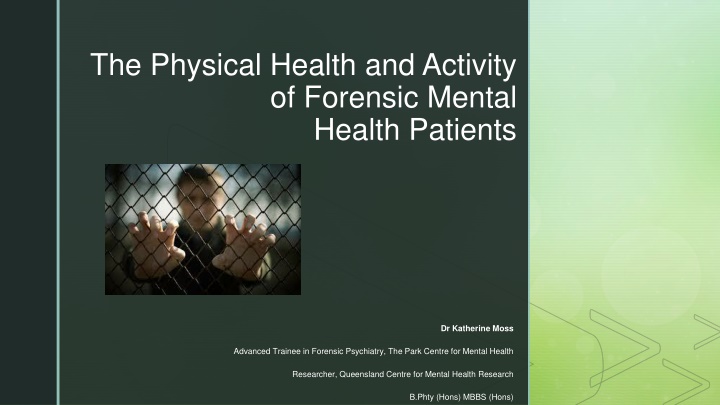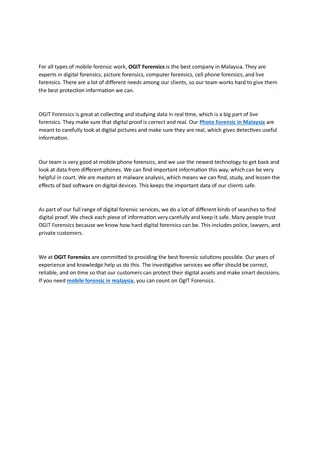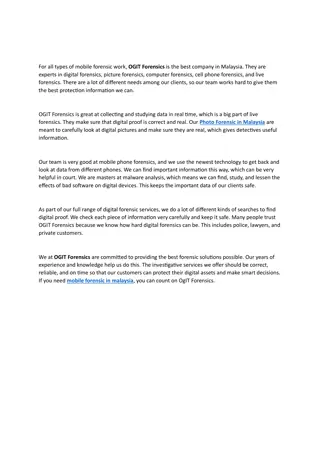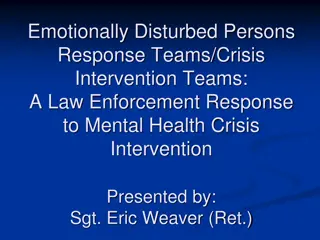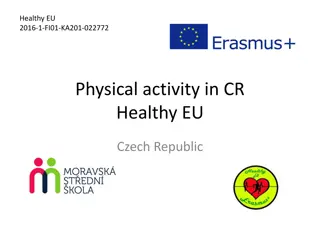Physical Health and Activity of Forensic Mental Health Patients Research Project
The research project focuses on investigating the prevalence of obesity, overweight, and weight gain among forensic mental health patients. It aims to develop and implement a physical activity intervention for patients in secure forensic settings to improve their overall health outcomes. The project involves data collection, intervention design, and long-term assessment of physical activity levels and health outcomes.
Uploaded on Sep 17, 2024 | 3 Views
Download Presentation

Please find below an Image/Link to download the presentation.
The content on the website is provided AS IS for your information and personal use only. It may not be sold, licensed, or shared on other websites without obtaining consent from the author.If you encounter any issues during the download, it is possible that the publisher has removed the file from their server.
You are allowed to download the files provided on this website for personal or commercial use, subject to the condition that they are used lawfully. All files are the property of their respective owners.
The content on the website is provided AS IS for your information and personal use only. It may not be sold, licensed, or shared on other websites without obtaining consent from the author.
E N D
Presentation Transcript
The Physical Health and Activity of Forensic Mental Health Patients Dr Katherine Moss Advanced Trainee in Forensic Psychiatry, The Park Centre for Mental Health Researcher, Queensland Centre for Mental Health Research B.Phty (Hons) MBBS (Hons)
Background We know people with severe mental illness have high rates of obesity We know that people with severe mental illness have low rates of physical activity What is happening in forensic psychiatric facilities? Australian Health Policy Collaboration (2018) Australia s Mental and Physical Health Tracker 2018
What is the prevalence of obesity and overweight in forensic psychiatric units? Australian Institute of Health and Welfare (2017) A picture of obesity in Australia Cormac et al 2005 36% men and 75% women were obese (N=248, Rampton Hospital, UK) Ojala et al (2008) >33% were obese and metabolic syndrome was found in 33% of the sample (N=221, Forensic psychiatric unit, Finland) Haw and Rowell (2011) 47% men and 63% women were obese (N=234, secure forensic unit, UK) Hilton et al (2015) 33% were obese (N=291, Ontario Maximum Secure Psychiatric Hospital, Canada) Every-Palmer et al (2018) 94% of patients were overweight/obese (N= 51, forensic and rehabilitation inpatients, NZ)
What about weight gain in forensic psychiatric units? Cormac et al (2005) mean increase in weight during admission 10.62kg in men and 12.7kg in women Haw and Rowell (2011) 103/234 patients had gained weight (median 2.9kg) Hilton et al (2015) average gain of 12% of body weight, 40% increased by at least 1 BMI category, average gain of 3.67kg/month Huthwaite et al (2017) - 47.2% of their sample of (N=36) gained weight Every-Palmer et al (2018) 75% attempting to lose weight
Research project plan The development and implementation of a physical activity intervention for patients with serious mental illness residing in a high secure forensic setting Phase 1 collection of data to inform the current health status and current physical activity levels of patients Phase 2 collection of data to inform physical activity intervention (physical activity questionnaire, semi-structured interview) Phase 3 design and implementation of a physical activity intervention and evaluation (this will include a wait list control design) Longer term plan ongoing assessment of physical activity levels, physical health outcomes and implementation strategies over time
What can patients expect when they go to a forensic psychiatric facility? Meet Peter
What can patients expect when they go to a forensic psychiatric facility?
Physical health at The Park, Centre for Mental Health (2010) In High Secure Unit: 58/60 were assessed BMI: 30.4 + 5.7 kg/m2 Waist Circumference (Males): 107.6 + 14.2 cm Waist Circumference (Females): 105.2 + 27.3 cm HDL: 0.84 + 0.24 mmol/L Triglycerides: 2.06 + 1.34 mmol/L % with Metabolic Syndrome: 56%
Physical health at The Park, Centre for Mental Health (2019) 10 consumers at The Park, Centre for Mental Health Av BMI 30.4 +/- 7.1kg/m2 (50% obese) Av waist circumference 110.8 +/- 18.5cm Metabolic Syndrome 30% Weight change 3.74kg +/- 7.70kg Triglycerides 1.6 +/- 0.86
Physical health data comparison from The Park: 2010 vs 2019 2010 2019 Body Mass Index: kg/m2 % Overweight % Obese Waist Circumference (Males): cm Waist Circumference (Females): cm Metabolic Syndrome Weight gain from admission: kg 30.4 + 5.7 26 52 107.6 + 14.2 105 + 27.3 56 -1.12 + 7.71 30.4 + 7.1 40 50 111.3 + 19.6 106 30 3.74 + 7.70
Physical activity of patients with serious mental illness Vancampfort et al (2017) Meta-analysis investigating sedentary behaviour and physical activity levels and their correlates in people with severe mental illness Mean amount of moderate or vigorous activity was 38.4min per day (268min/week) - significantly lower than healthy controls Significantly less likely than matched healthy controls to meet physical activity guidelines Bergman et al (2018) Mean physical activity was 268 min/week, 1181 MET-minutes per week 9/25 patients did not meet the international recommendations
Current physical activity levels of patients at The Park 6 patients < 600 MET-minutes per week 1 patient 600-1000 MET-minutes per week 3 patients >1000 MET-minutes per week Mean 834.7 MET-minutes per week IPAQ-SF Responses IPAQ-SF Intermediary Calculations IPAQ-SF Final MET-Minutes and Categorical Scores Categorical Score Criteria Vigorous (min/d) Moderate (min/d) Walking (min/d) TOTAL DAYS OF ACTIVITY PHYSICAL ACTIVITY CATEGORY Vigorous Activity Moderate Activity Walking Activity Sitting TOTAL ACTIVITY (min/wk) MET-MINUTES PER WEEK High Activity Criteria Moderate Activity Criteria Participant ID Days Min Days Min Days Min Hours 3 Days Vig ( 1500 MET- min/wk) 7 Days Any ( 3000 MET- min/wk) 5 Days Mod/Walk ( 30 min/d) 5 Days Any ( 600 MET- min/wk) (Q2 (Q4 (Q6 Days (Recoded) (Self- Reported) Category (Recoded) 3 Days Vig ( 20 min/d) Q1 Q2 Q3 Q4 Q5 Q6 Q7 Truncated) Truncated) Truncated) Days (Truncated) Vigorous Moderate Walk Total Category 1 1 30 2 75 7 60 240 30 75 60 N N N Y Y 10 7 165 165 240 600 1386 2226 Moderate 2 2 0 0 0 0 7 10 0 0 10 N N N N N 7 7 10 10 0 0 231 231 Low 1 3 0 0 0 0 6 30 300 0 0 30 N N N Y N 6 6 30 30 0 0 594 594 Moderate 2 4 0 0 0 0 1 10 360 0 0 10 N N N N N 1 1 10 10 0 0 33 33 Low 1 5 0 0 5 90 0 0 630 0 90 0 N N N Y Y 5 5 90 90 0 1800 0 1800 Moderate 2 6 0 0 0 0 3 10 480 0 0 10 N N N N N 3 3 10 10 0 0 99 99 Low 1 7 0 0 0 0 3 90 630 0 0 90 N N N N N 3 3 90 90 0 0 891 891 Low 1 8 0 0 0 0 0 0 660 0 0 0 N N N N N 0 0 0 0 0 0 0 0 Low 1 9 0 0 1 60 7 15 180 0 60 15 N N N N N 8 7 75 75 0 240 346.5 587 Low 1 10 0 0 5 25 7 60 480 0 25 60 N N N Y Y 12 7 85 85 0 500 1386 1886 Moderate 2
Interventions in a forensic setting Study Setting Partic ipants Study Design Intervention Findings Bacon et al 2012 Australia Secure mental health hospital (116 beds) 2 Mixed methods Before-after evaluation (8 weeks) Group session with training x2 per week; individual sessions Weight loss for both participants (3.4kg; 1kg) Cormac et al 2008 UK High secure psychiatric unit 95 Before-after evaluation (10-12 weeks) 1hr fitness session + weight management education session (+ optional 1hr fitness session) Mean weight loss 1.3kg, mean waist size reduction was 2cm Cormac et al 2013 UK High secure psychiatric unit 102 Before-after evaluation (10-12 weeks) - 14 programmes 1hr fitness session + weight management education session (+ optional 1hr fitness session) Mean weight loss 1.3kg 63% lost weight 21/76 lost >5kg Long et al 2015 UK Low and medium secure psychiatric unit 32 Before-after evaluation Environmental interventions including 30mins of activity on ward per day, flashcards, supervised group exercise, prioritised time-tabling of PA, incentives No significant changes in weight, BMI, body fat, muscle mass, bone mass, metabolic age or PEF. ~1/3 lost weight Savage et al 2009 UK Medium secure forensic unit 6 Before-after evaluation (12 weeks) Personalised training programme, 1:1 basis, one session per week for 12 weeks Combination of aerobic (e.g. cycling and weight-training) A statistically significant improvement in service users self-reported feelings of relaxation, happiness and calmness followed engagement in personal training sessions. Tetile et al 2008 Norway Secure forensic mental health hospital 15 Before- after evaluation (8-12 weeks) Exercise 3 x per week (2 indoor and 1 outdoor) Statistically significant improvements were found in resting heart rate and systolic blood pressure. No significant changes found in weight/BMI. Wynaden et al 2012 Australia Secure forensic mental health hospital 56 Mixed methods evaluation (6 months) Education sessions and formal exercise programme Range of individual, group and team exercises 30-60 min/day 40.6% reported programme was enjoyable 26.4% reported it was useful, 21.7% reported it made them feel better 15.4% thought their fitness was improved and 13% though it helped them cope with stress
What happened to Peter? Has been inpatient for 5.5 years Put on 14.7kg Diagnosed with metabolic syndrome in 2019 Cardiomyopathy from clozapine, on B-blocker IPAQ-SF 1888 MET-minutes per week Awaiting review for consideration of rehabilitation ward
Things to consider Where? Ward, courtyard, gym, outside exercise equipment When? Current campus walks 4:30-5:30pm but specialist staff have gone home by then Consider other rehabilitation needs What? Low, moderate, high intensity, what "dose" of exercise Who? Group vs Individual vs Choice of either Supervision Why? Increase activity, reduce cardiovascular risk, weight loss, improve psychiatric symptoms, reduce stress, improve sleep
Conclusions The physical health and health needs of patients at The Park has not really changed over the past 9 years Patients currently do a variety of different physical activities to meet their needs (campus walks, gym, swimming) but there is no one overseeing this Addressing the physical health needs of forensic patients is complex Illness factors, environmental factors, risk factors, motivation factors, movements in/out of facilities Current studies small numbers, staff shortages during studies, no control group, recruitment rates 52-70.3%, attrition rates 13-55% Where to from here Phase 2 collection of data to inform physical activity intervention (physical activity questionnaire, semi-structured interview) Phase 3 design and implementation of a physical activity intervention and evaluation (this will include a wait list control design)
References Australian Health Policy Collaboration (2018) Australia s Mental and Physical Health Tracker 2018 https://www.vu.edu.au/sites/default/files/australias-mental-and-physical-health-tracker-report-card.pdf Australian Institute of Health and Welfare (2017) A picture of obesity in Australia https://www.aihw.gov.au/getmedia/172fba28-785e-4a08-ab37-2da3bbae40b8/aihw-phe-216.pdf.aspx?inline=true Bacon, N., Farnworth, L., & Boyd, R. (2012). The use of the Wii-fit in Forensic Mental Health: Exercise for People at Risk of Obesity. British Journal of Occupational Therapy, 75(2): 61-68. Bergman, H., Nilsson, T., Andine, P., et al. (2018). Physical performance and physical activity of patients under compulsory forensic psychiatric inpatient care. Physiotherapy Theory and Practice, DOI: 10.1080/09593985.2018.1488320 Cormac, I., Ferriter, M., Benning, R. & Saul, C. (2005) Physical health and health risk factors in a population of long-stay psychiatric patients. Psychiatric Bulletin, 29, 18-20. Every-Palmer, S., Huthwaite, M.A., Elmslie, J.L., Grant, E &Romans, S.E. (2018). Long-term psychiatric inpatients perspectives on weight gain, body satisfaction, diet and physical activity: a mixed methods study. BMC Psychiatry, 18, 300. Farnworth, L., Nikitin, L & Foessey, E. (2004). Being in a Secure Forensic Psychiatric Unit: Every Day is the Same, Killing Time or Making the Most of it. British Journal of Occupational Therapy, 67 (10), 430-438. Haw, C & Rowell, A. (2011). Obesity and its complications: a survey of inpatients at a secure psychiatric hospital. The British Journal of Forensic Psychiatry, 13, 270-277. Hilton, N.Z., Ham, E., Lang, C.L., & Harris, G.T. (2015). Weight Gain and Its Correlates Among Forensic Inpatients. The Canadian Journal of Psychiatry, 60, 232-238. Ojala, K., Niskanen, L., Tiihonen, J., Paavola, P, Putkonen, A & Repo-Tiihonen, E. (2008). Characterisation of metabolic syndrome among forensic psychiatric patients. The Journal of Forensic Psychiatry and Psychology, 19, 33-51. Vancampfort, D., Firth, J., Schuch, F.B., Rosenbaum, S., Mugisha, J., Hallgren, M., Probst, M., Ward, P.B., Gaughran, F., De Hert, M., Carvalho, A.F & Stubbs, B. (2017). Sedentary behavior and physical activity levels in people with schizophrenia, bipolar disorder and major depressive disorder: a global systematic review and meta-analysis. World Psychiatry, 16, 308-315. Wynaden, D., Barr, L., Omari, O., & Fulton, A. (2012). Evaluation of service users experiences of participating in an exercise programme at the Western Australian State Forensic Mental Health Services. International Journal of Mental Health Nursing, 21, 229 235.
